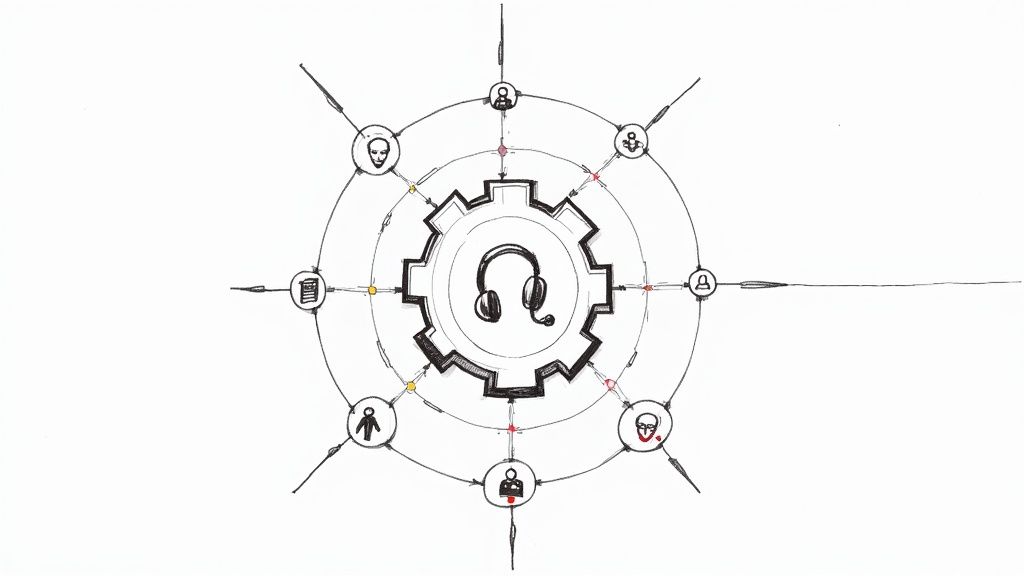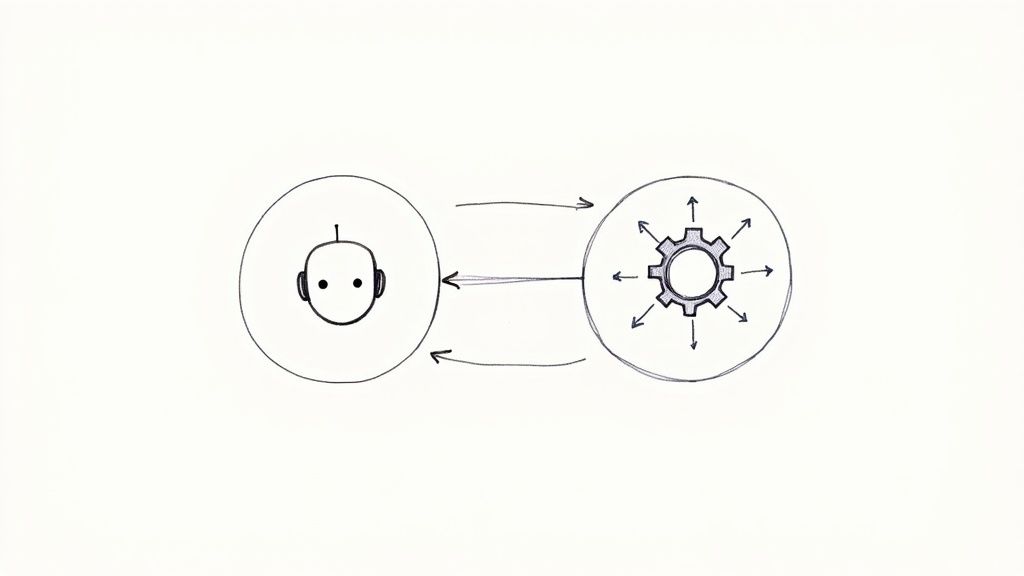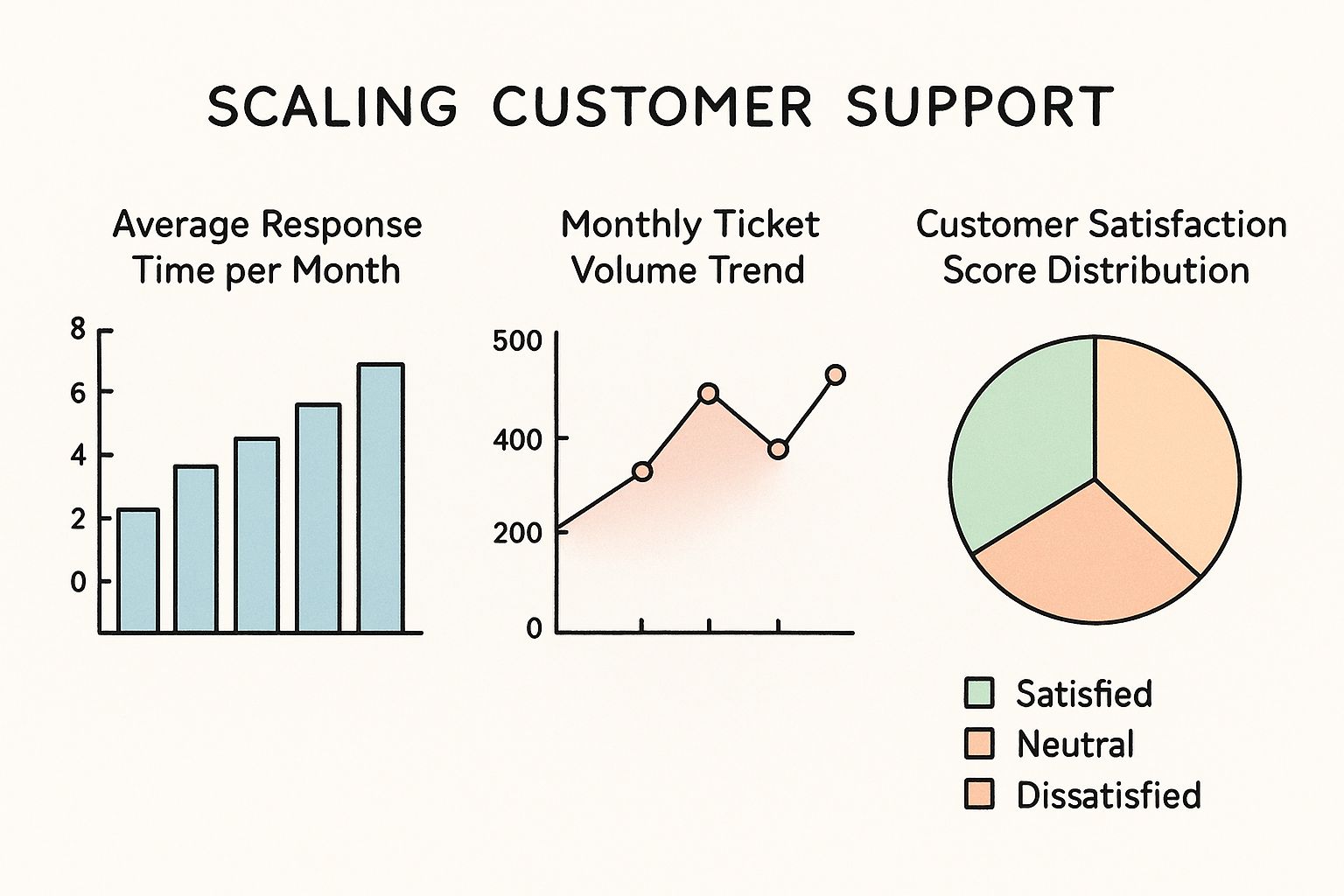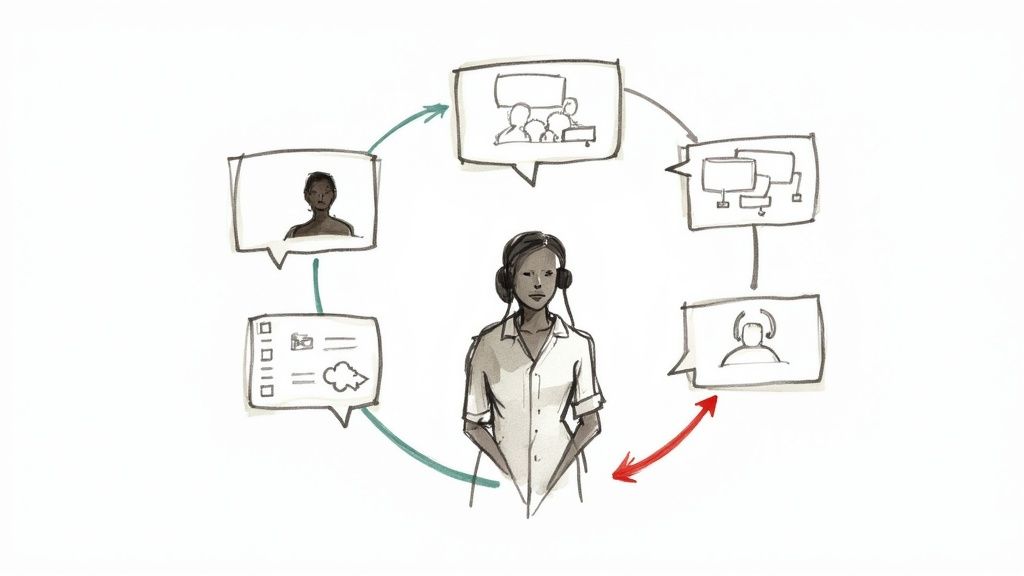
Scaling Customer Support: Proven Strategies to Boost Growth
Why Scaling Customer Support Is No Longer Optional
Customer support has dramatically changed. It's no longer just a cost, but a key driver of customer loyalty, brand differentiation, and revenue growth. Customers today expect seamless, personalized experiences, and they have little patience for long waits and generic answers. This shift in expectations puts immense pressure on traditional support models, often leaving them struggling to keep up.
This means businesses must prioritize scaling customer support to thrive in today’s competitive market. Scaling support operations directly impacts key metrics like customer retention and lifetime value. Companies that master this see a real return on investment, turning satisfied customers into loyal advocates. However, many struggle to balance rapid growth with high-quality customer interactions. Building a scalable foundation early on, often with platforms like WordPress, is often key.
The Business Impact of Scalable Support
Scaling support effectively is directly tied to positive business outcomes. Reduced response times lead to happier customers, which in turn builds loyalty. Streamlined support processes can also significantly cut operational costs, freeing up resources for other important initiatives. This is especially true as customer bases grow, demanding more efficient and effective support.
The market itself reflects the growing importance of scalable support. The global customer service software market illustrates this point. In 2024, this market was valued at about 4.9 billion. It's projected to reach 8.19 billion by 2031, a CAGR of nearly 21% over seven years. This explosive growth highlights the vital role of scaling customer support for businesses worldwide. You can find more detailed statistics here. Clearly, investing in scalable support solutions isn't just a trend; it's essential for sustained growth and competitive advantage.
Building Support Architecture That Handles 10X Growth

Scaling customer support isn't just about hiring more agents. It requires a strong foundation. Think of it like building a house: adding more rooms without reinforcing the foundation will lead to problems. Similarly, expanding your support team without a solid framework isn't sustainable. Leading companies focus on modular support frameworks that adapt to rapid growth.
Key Principles of Scalable Support Architecture
A scalable architecture lets your support operations grow smoothly. This involves creating standardized processes that remain consistent, even with changing ticket volumes. Key decisions about ticket routing, knowledge management, and team structure are crucial for scaling without drastically increasing costs. It's like building with Lego blocks: each piece is standardized, but can be combined in many ways to create complex structures.
- Modular Design: Divide your support system into separate modules (e.g., live chat, email, ticketing). This simplifies updates and scaling without affecting other parts of the system.
- Automation: Automate tasks like ticket routing, initial responses, and knowledge base integration. This frees up agents to handle complex issues.
- Self-Service Resources: Empower customers to find their own answers with a comprehensive knowledge base, FAQs, and community forums. This reduces ticket volume and improves customer satisfaction.
Ticket Routing and Knowledge Management
Effective ticket routing ensures inquiries get to the right agent quickly. This reduces resolution time and makes customers happier. Imagine a well-organized library: a good system helps you find the book you need. Similarly, a strong routing system directs inquiries efficiently.
Knowledge management is also critical. A readily available knowledge base helps both customers and agents. Agents can quickly find answers to common issues, and customers can often solve problems on their own. This boosts efficiency all around.
Building a Flexible Team Structure
A scalable team structure adapts to changing needs. This involves careful planning and a focus on specialized roles and cross-functional collaboration. Dedicated teams for specific products or customer segments can improve efficiency. This lets agents develop expertise, leading to faster resolutions.
To illustrate the components of a scalable support framework, let’s review the table below. It offers a detailed breakdown of the elements required for a support system built for growth.
Components of a Scalable Support Framework
This table breaks down the essential building blocks of a support system designed for growth.
| Component | Purpose | Scalability Factor | Implementation Complexity |
|---|---|---|---|
| Knowledge Base | Self-service support | High | Medium |
| Automated Ticket Routing | Efficient workflow | High | Medium |
| Integrated CRM | Unified customer data | High | High |
| Real-time Analytics | Performance monitoring | High | Medium |
| Agent Training Programs | Skill development | Medium | Medium |
As you can see, different components offer different benefits. While a knowledge base is relatively straightforward to implement and offers significant scalability, integrating a comprehensive CRM requires greater effort. However, the insights it provides into customer data are essential for a holistic support strategy.
By focusing on these architectural elements, businesses can build customer support systems ready for 10x growth, paving the way for long-term success. This ensures that support scales smoothly and effectively without sacrificing quality.
Selecting Technology That Enables True Scalability

Choosing the right technology is vital for scaling customer support. It's about finding tools that not only meet your current needs but also adapt as your business grows. Evaluating solutions based on their scalability potential is key for long-term success, preventing costly system replacements later.
Evaluating Solutions for Long-Term Growth
Your support technology is like the engine of your operations. A powerful engine allows for smooth acceleration as your business expands. The right tech helps your team handle increasing customer inquiries without affecting quality. This involves considering factors like integration capabilities, automation features, and data analysis tools.
- Integration: Seamless integration with existing systems like your CRM and marketing automation platform is critical. A fragmented tech stack can create data silos, reducing efficiency and personalization.
- Automation: Automated ticket routing, chatbot responses, and knowledge base integration free up your agents. This lets them focus on complex issues and improves productivity.
- Data Analysis: Robust reporting and analytics offer insights into agent performance, customer satisfaction, and areas for improvement. This data-driven approach helps optimize operations and inform scaling decisions.
The Power of Integrated Technology Ecosystems
Integrated ecosystems, rather than disconnected tools, are crucial for scaling support. A unified platform improves data flow, streamlines processes, and gives a complete view of the customer journey. This allows for better personalization and more proactive support.
For example, integrating your live chat with your CRM gives agents instant access to customer history. This allows for more personalized and efficient interactions. Check out this helpful guide on how to master customer support automation.
Implementing and Measuring ROI
Successfully implementing new technology needs careful planning. Focusing on change management, user training, and clear communication ensures smooth adoption within your team. Also, defining key performance indicators (KPIs) and tracking return on investment (ROI) is crucial.
This might include measuring metrics like:
- Reduced support costs
- Improved customer satisfaction scores
- Increased first contact resolution rates
Tracking these metrics shows the value of your technology investments and informs future strategies. The combination of AI and automation is changing how customer support scales. It lets companies handle growing demand without needing a similar increase in staff.
By 2025, almost 90% of customer interactions are predicted to be handled without human involvement. This will be through AI-powered chatbots, voice assistants, and predictive analytics. You can find more statistics here. This allows support teams to stay efficient even with a significantly larger customer base. Building your technology roadmap with scalability as the central focus keeps your support operations adaptable, efficient, and customer-centric.
Finding the Sweet Spot Between Bots and Humans
Today's customer support environment needs to be both efficient and personal. This presents a key challenge: figuring out which customer interactions truly need a human touch and which can be handled effectively through automation. Finding this balance is essential for scaling customer support successfully.
Understanding the Customer Journey
Analyzing customer behavior and preferences helps determine the right mix of bots and humans. Some situations, like complex technical issues or emotionally charged complaints, definitely need the nuanced understanding and empathy of a human agent.
Other interactions, such as simple order tracking or password resets, are perfectly suited for automated solutions. This allows your human agents to focus on more complex issues.
For example, a customer frustrated with a faulty product needs empathy and a personalized solution – something a bot can't provide. However, a customer simply looking for store hours can quickly find that information through an automated system. Choosing the right technology is critical for scalability. Explore how AI in Customer Support can improve your support strategy. This strategic approach optimizes resources and enhances the overall customer experience.
Empowering Human Agents Through AI
Leading companies use AI not to replace human agents, but to empower them. AI can handle routine tasks, freeing up human agents to focus on situations requiring empathy and complex problem-solving. This creates a powerful partnership where AI enhances human capabilities.
Think of it as giving your support team superpowers: they can handle more complex issues, faster, and with greater personalized attention.
This approach ensures that human connection remains at the heart of your support strategy, even as you grow. By automating routine tasks, your agents can focus their energy where it matters most: building rapport and providing solutions to complex customer problems.
Designing a Balanced Approach
Building a support system that blends automation and human interaction requires careful planning. This involves mapping the entire customer journey and identifying which touchpoints benefit most from each approach. This strategy creates a seamless experience that leverages the strengths of both bots and humans.
To understand which support scenarios benefit most from automation versus human intervention, let’s take a look at the following table.
Support Interaction Types: Automation vs. Human Touch
Analysis of which support scenarios benefit most from automation versus human intervention
| Interaction Type | Automation Potential | Human Value Add | Recommended Approach |
|---|---|---|---|
| Simple FAQs | High | Low | Automated |
| Order Tracking | High | Low | Automated |
| Technical Troubleshooting (Complex) | Medium | High | Human-assisted by AI |
| Complaint Resolution | Low | High | Human with AI insights |
| Product Feedback | Medium | High | Human with AI analysis |
This strategic allocation of resources ensures you're providing the right level of support at the right moment. It’s important to continuously analyze and adjust this balance as your support operation scales. This ensures your system remains effective and efficient even as customer needs and business demands change. This ongoing refinement is crucial for maintaining a high level of customer satisfaction and operational efficiency.
Scaling The Human Element In Customer Support
Scaling customer support comes with a tricky balancing act: how do you keep things personal as your team and customer base grow rapidly? The key is changing your perspective. Instead of seeing customer support as a cost, see it as a vital part of your growth plan. This section explores how successful companies maintain, and even improve, their support culture as they expand.
Hiring, Training, And Retaining Top Talent
A scalable support team starts with the right people. Look for agents with a mix of technical skills and genuine empathy. These individuals can solve problems efficiently while also connecting with customers. This combination is essential for delivering excellent service, no matter how big you get. You might be interested in: How to master human-AI collaboration in customer support.
Once your team is in place, ongoing training is crucial. Create scalable training programs that reinforce your core service values while also adapting to changing customer needs. This ensures consistent, high-quality support from all agents, regardless of their experience level. Don't forget about retention! Recognize and reward your top performers to cultivate a positive and supportive work environment.
Fostering A Customer-Centric Culture
No matter your team’s size, a customer-obsessed culture is essential for scaling effectively. This involves open communication, clear expectations, and empowered team members. Regular team meetings, feedback sessions, and professional development opportunities help build this kind of environment. It's like creating a strong community where everyone feels valued and works towards a shared objective.
Strong leadership is also key. Give your support leaders the skills to motivate and manage their teams effectively, even as those teams expand. This ensures your support organization can handle increased volume without compromising quality or employee satisfaction.

The infographic above visualizes key metrics related to scaling success: average response time, ticket volume trends, and customer satisfaction scores. As the data shows, ticket volume has naturally increased with growth. However, average response times have stayed consistently low, and customer satisfaction remains high. This points to a successful scaling strategy.
This success is further highlighted by the growing importance of customer experience (CX). Data suggests that by 2025, 80% of companies plan to increase CX investments. This demonstrates that improved customer support is now central to competitive strategy. What’s more, 70% of customers expect support representatives to have a complete understanding of their situation. This encourages companies to unify data across channels for a seamless service experience. Learn more about customer service statistics here. By focusing on both technology and the human touch, companies can effectively scale their support operations while delivering exceptional experiences for their customers.
Measuring What Matters in Scalable Support

As your customer base expands, so should your support capabilities. But how do you know you're tracking the right metrics? This section explores how successful organizations monitor the key performance indicators (KPIs) that truly predict success when scaling customer support. It's time to move beyond the conventional and embrace a more holistic view.
Beyond Traditional Metrics: A Balanced Scorecard Approach
Many companies rely heavily on traditional metrics like average handle time and resolution time. However, these metrics don't always paint a complete picture. A balanced scorecard approach considers operational efficiency alongside customer experience and business impact. This provides a much more comprehensive view of your support performance. For instance, a low average handle time might seem positive, but it could also indicate agents are rushing through interactions, negatively impacting customer satisfaction.
A truly effective approach combines metrics like First Contact Resolution (FCR) and Customer Satisfaction (CSAT) scores with business outcomes like customer lifetime value. This gives you valuable insights to make smarter decisions. Learn more about measuring customer satisfaction. This multifaceted view allows you to see the bigger picture and identify areas for improvement.
Identifying Predictive Metrics for Scaling Success
High-performing support organizations use predictive metrics to foresee potential problems before they affect customers. This proactive approach ensures a smoother customer experience.
Some key predictive metrics include:
- Ticket Volume Trends: Analyzing trends in ticket volume helps reveal underlying issues or predict future demand. A sudden spike in tickets related to a specific product feature might suggest a bug or usability problem.
- Channel Utilization: Understanding how customers use different support channels (phone, email, live chat) lets you optimize resource allocation and provide support precisely where customers need it most.
- Agent Performance Variation: Identifying discrepancies in agent performance helps highlight opportunities for additional training or process improvements. This targeted approach ensures consistent service quality across your team.
By using these predictive metrics, you can make proactive scaling decisions instead of simply reacting to problems.
Building a Measurement System That Scales
Your measurement system must evolve alongside your business. This means establishing clear benchmarks at each stage of growth and implementing adaptable measurement practices. The metrics that work for a startup with a small customer base will differ significantly from those needed by a large enterprise.
Focus on the most relevant metrics at each stage of your company's growth. This ensures your measurement system stays relevant and continues providing useful insights.
Data-Driven Decisions for Proactive Scaling
Data-driven support leaders use insights gleaned from their measurement systems to make strategic decisions. These decisions relate to resource allocation, technology investments, and process optimization. Being proactive allows them to stay ahead of potential challenges and ensure their support operations can handle future growth.
Data empowers you to anticipate support issues and take steps to reduce their impact, improving both customer satisfaction and operational efficiency.
Streamline your support and boost your bottom line with Chatisto, the AI-powered customer support platform designed for scaling businesses. Visit Chatisto today to learn more.